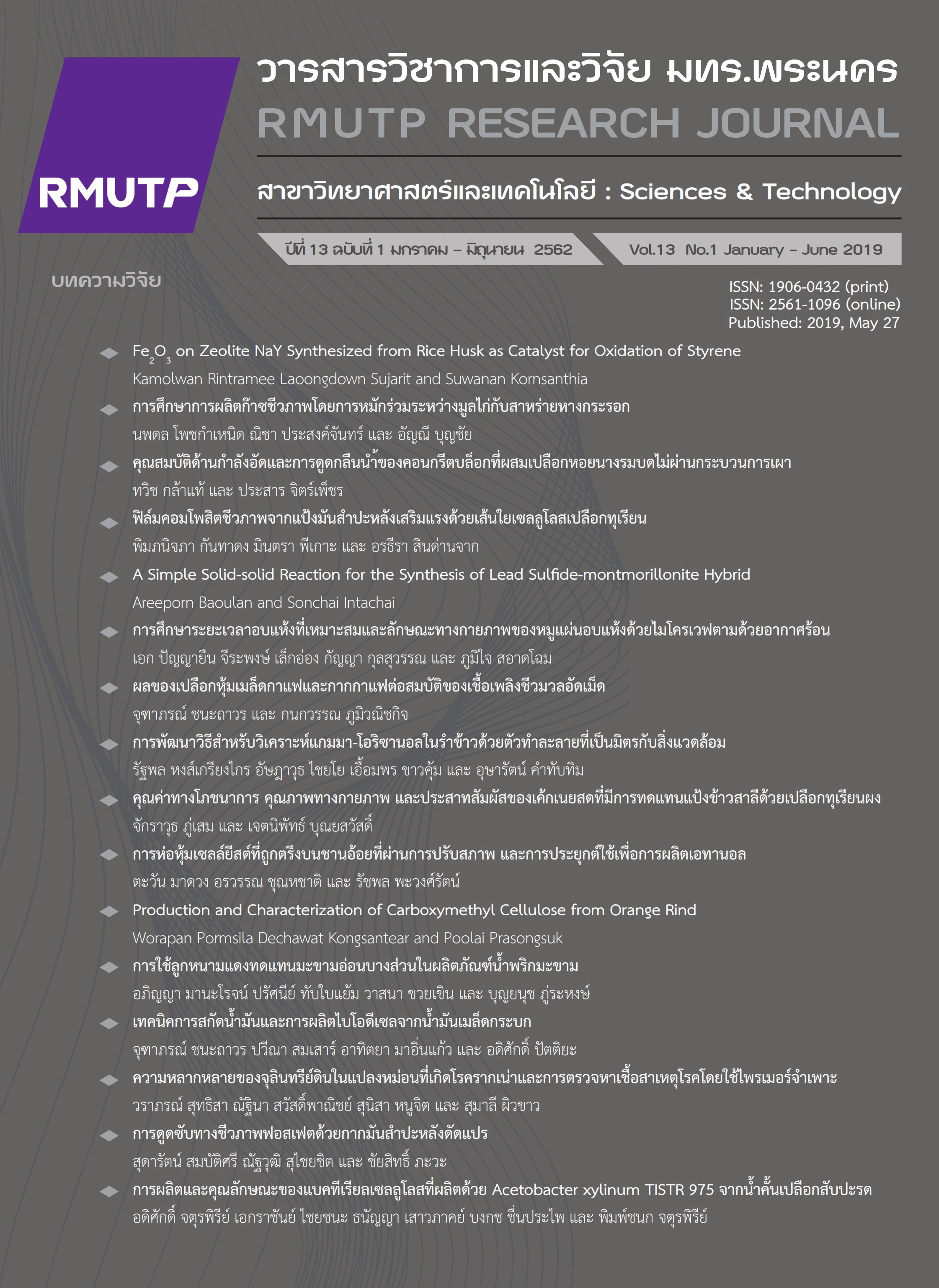Encapsulation of Immobilized Yeast Cells on Pretreated-bagasses and Its Application Use for Ethanol Production
Main Article Content
Abstract
Most of ethanol production processes are limited by low ethanol production rate and recyclable problem of ethanologenic organisms. In the present study, Saccharomyces cerevisiae TISTR 5339 entrapped in an aqueous mixture of alginate and pretreated-bagasse was used for ethanol production of immobilization parameter of yeast cells consisting of amount of bagasse and alginate concentration on ethanol production were investigated. The results showed that increase in alginate concentration and the amount of bagasse can increase structural strength and reduce deterioration of bead. The optimal condition of immobilization was 1.0 % (w/v) bagasse and 2.5% alginate. Ethanol yield (Yp/s) ethanol production rate (Qp) and efficiency of fermentation (Ey) obtained from the bagasse-alginate immobilized yeast cell was 3.39±0.72 g/l 0.14±0.03 g/l/h and 70.98±14.08% respectively. The ultrastructure obtained from SEM illustrated that S. cerevisiae TISTR 5339 was well incorporated within the bagasse-alginate matrix. Moreover, the bagasse-alginate immobilized yeast cells were reusable at least 5 times with Ey higher than 50% of 1st round of fermentation. Therefore, the pretreated bagasse-alginate immobilized yeast cells is an alternatively interesting techniques with effiiciency for ethanol production in the future.
Article Details
References
จารุวรรณ เจียดอนไพร. 2557. สภาวะที่เหมาะสมในการตรึงเชื้อยีสต์บนชานอ้อย และการประยุกต์ใช้เพื่อผลิตเอทานอล. ปริญญาวิทยาศาสตรบัณฑิต. มหาวิทยาลัยเกษตรศาสตร์
นงลักษณ์ ศรีอุบลมาศ. 2540. เอกสารประกอบการสอนวิชา pharmaceutical biotechnology เรื่อง Cell and enzyme immobilization. คณะเภสัชศาสตร์ จุฬาลงกรณ์มหาวิทยาลัย. 2540
ประวิทย์ เจียมจวนขาว อรัญ หันพงศ์กิตติกูล และ เบญจมาศ เชียร์ศิลป์. 2550. สภาวะที่เหมาะสมในการตรึงเอนไซม์ไลเปสด้วยอัลจิเนตเพื่อย่อยน้ำมันปามโอเลอีน. วารสารสงขลานครินทร์ ปีที่ 29 (ฉบับพิเศษที่ 2) : 261-267
เวสารัช สุนทรชัยบรูณ์ และ รัชพล พะวงศ์รัตน์. 2556. การใช้ประโยชน์วัสดุพยุงจากขยะธรรมชาติสำหรับการตรึงเซลล์ และประยุกต์ใช้ในการผลิตเอทานอล. Veridian E-Journal 6(1):795-807
ขนิษฐา ฤกษ์อรุณ สุรีย์มาศ อาจหาญ อรวรรณ ชุณหชาติ และ รัชพล พะวงศ์รัตน์. 2558. ศักยภาพและการใช้ประโยชน์จากลำต้นแก่นตะวันเพื่อเป็นวัสดุตรึงเซลล์ยีสต์. วารสารเกษตรพระวรุณ. ปีที่ 12 (ฉบับที่ 2) : 106-113.
Abhishek M., A.K. Sharma, S. Sharm, R. Bagai, A.S. Mathur, R.P. Gupta, D.K. Tuli. 2016. Lignocellulosic ethanol production employing immobilized Saccharomyces cerevisiae in packed bed reactor. Renewable Energy 98: 57-63.
Beom, s., H., H.Joo kim. O. Kyu Lee, J. Hye Ha, H.zyong Lee and K.Hwan jung. 2009. Measurement of ethanol concentration using solvent extraction and dichromate oxidationand its application to bioethanol production process .J lnd microbial Biotechnol. 36:285-292
Bibin, M. C., A. L. Leaoa, S. F. Souzab, L. M. M. Costab, G. M. Olyveirab, M. Kottaisamyc, E.R. Nagarajand and S.Thomase., 2011. Cellulose nanocomposites with nanofibres isolated from pineapple leaf fibers for medical applications. Carbohyd Polym. 86: 1790– 1798.
Davarcı, F., D. Turan, B. Ozcelik and D. Poncelet. 2017. The influence of solution viscosities and surface tension on calciumalginate microbead formation using dripping technique. Food Hydrocolloids 62: 119-127.
Jame, c.s. 1995. Analytical chemistry of foods. London : Blackie A&PKwang Ho, L., I.S.Choi, Y-G. kim, D-J yang and H-J bae. 2011. Enhanced production of bioethanol and ultrastructural characteristics of reused Saccharomyces cerevisiae immobilized calcium alginate beads. Bioresource Technology. 102: 8191-8198.
Razmovski, R., and V. Vucurovi. 2010. Ethanol production from sugar beet molasses by S. cerevisiae entrapped in an alginate–maize stem ground tissue matrix. Enzyme and Microbial Technology. 48: 378-385.
Pajic-Lijakovic, I., S. Levic, M. Hadnad.ev, Z. Stevanovic-Dajicb, R. Radosevic, V. Nedovic and B. Bugarskia. 2015. Structural changes of Ca-alginate beads caused by immobilized yeast cell growth. Biochemical Eng. J. 103: 32-38
Shahrulzaman, S. and I. I. Muhamada. 2014. Microencapsulation of alginate-immobilized bagasse with Lactobacillus rhamnosus NRRL 442: Enhancement of survivability andthermotolerance. Carbohyd Polym. 119 : 173–18

